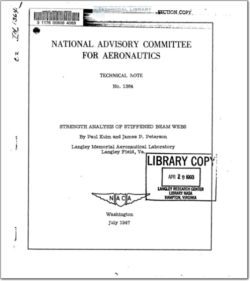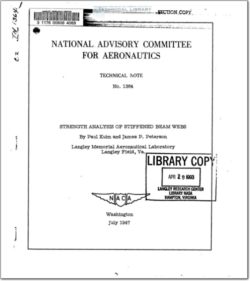NACA-TN-1364

- Version
- 240 Downloads
- 2.21 MB File Size
- 1 File Count
- December 4, 2015 Create Date
- December 4, 2015 Last Updated
National Advisory Committee for Aeronautics, Technical Notes - Strength Analysis of Stiffened Beam Webs

A previously published method for strength analySis of stiffened
shear webs has been revised and extended. A set of formulas and
graphs which cover all aspects of strength analysis is given,
experimental data are presented, and the accuracy of _the formulas
as Judged by comparison with these data is discussed. Revisions
of some formulas have resulted in improved agreement with experi-
mental stresses and with more rigorous theory, particularly for
low ratios of applied shear to buckling shear. The scope of the
experimental evidence has been greatly increased compared with the
previous paper by incorporating the results of several investigations
undertaken since then.
Many of the shear webs used in aircraft structures are so thin
that they buckle at a fraction of the ultimate load. A purely
mathematical theory of basically simple-form has been developed
for the limiting case of webs so thin that their resistance to
buckling is entirely negligible (reference 1). This theory of
pure diagonal tension is too conservative for practical use
because the resistance to buckling of practical webs incomplete-
diagonal-tension webs is far from being negligible. A mathe-
matical theory of incomplete diagonal tension has been developed
(reference 2), but it requires such extensive calculations that
its adaptability to stress analysis is questionable; moreover, no
adequate check of its accuracy by comparing it with test results
over a wide range has been published, and it is not sufficiently
complete to explain upright failures, probably the most important
item in the design of web systems.
In the face of such difficulties, practical stress-analysts
have often resorted to entirely empirical formulas. There are
two objections to such a procedure: Without the benefit of some
guiding theoryJ a very large number of tests is required to insure
the reliability of a given formula, and a formula established for
the strength of one part of a beam is usually of little, if any,
help in establishing formulas for other items.
| File | Action |
|---|---|
| naca-tn-1364.pdf | Download |

Comment On This Post